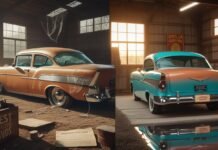The 1957 Chevrolet Bel Air restoration is a dream project for classic car enthusiasts, transforming a rusty barn find into a gleaming icon of American automotive history. Known for its iconic tailfins and chrome trim, the ’57 Bel Air is a symbol of 1950s style. This article takes you through the incredible journey of restoring a 1957 Chevrolet Bel Air, sharing insights, real-world examples, and actionable tips to inspire your own restoration adventure.
Why the 1957 Chevrolet Bel Air Restoration Captivates Enthusiasts
The 1957 Chevrolet Bel Air is more than a car—it’s a cultural icon. Its bold design and V8 power made it a favorite in its era, and today, restored models can fetch over $100,000 at auctions, per Hemmings. The 1957 Chevrolet Bel Air restorations process is both a labor of love and a rewarding challenge, bringing a piece of history back to life.
Finding the Perfect Barn Find for Restoration
- Check Condition: Look for minimal rust and a complete frame.
- Verify Authenticity: Confirm the VIN and trim tags match a 1957 Bel Air.
- Example: In 2020, a restorer in Ohio found a ’57 Bel Air in a barn, missing its engine but with an intact body, making it a prime restoration candidate.

Steps to a Successful 1957 Chevrolet Bel Air Restoration
Restoring a 1957 Chevrolet Bel Air requires planning, skill, and patience. Here’s a step-by-step guide:
1. Assess and Plan the Restoration
Evaluate the car’s condition and set a budget. Full restorations can cost $30,000-$70,000.
- Actionable Tip: Use Classic.com to estimate costs and market value.
2. Disassemble and Catalog Parts
Take the car apart carefully, labeling every piece to ensure accurate reassembly.
3. Repair the Body and Frame
Remove rust, weld new panels, and straighten the frame for structural integrity.
4. Restore the Engine and Mechanics
Rebuild the original V8 or source a period-correct engine for authenticity.
5. Paint and Chrome Finishing
Apply a high-quality paint job (e.g., Tropical Turquoise) and polish chrome trim for that classic shine.
6. Reassemble and Test
Put it all back together, then test-drive to ensure performance.

Challenges in 1957 Chevrolet Bel Air Restoration
- Parts Availability: Original parts are scarce; reproductions may not match quality.
- Cost Overruns: Unexpected repairs can inflate budgets.
- Skill Requirements: Bodywork and engine rebuilding demand expertise.
- Actionable Tip: Source parts from Eckler’s Chevy for authentic reproductions.
Tips for a Show-Stopping Restoration
- Stay Authentic: Use period-correct colors and parts for historical accuracy.
- Document the Process: Photos and videos can boost value and share your story.
- Join a Community: Connect with enthusiasts via ChevyTalk for advice and support.
- Example: A California restorer documented their ’57 Bel Air project on YouTube, gaining thousands of followers and a higher sale price.

The Reward of a Restored 1957 Chevrolet Bel Air
Completing a 1957 Chevrolet Bel Air restorations is a triumph. The car’s stunning design and smooth V8 roar turn heads at car shows, and its value can appreciate significantly. More than that, it’s a chance to preserve automotive history and create a personal legacy.
Conclusion: Start Your 1957 Chevrolet Bel Air Restoration Journey
The 1957 Chevrolet Bel Air restoration transforms a forgotten classic into a masterpiece. With careful planning, dedication, and the right resources, you can bring this icon back to life. Ready to start? Hunt for a barn find, join a car club, or research parts today to kick off your restoration adventure!






























